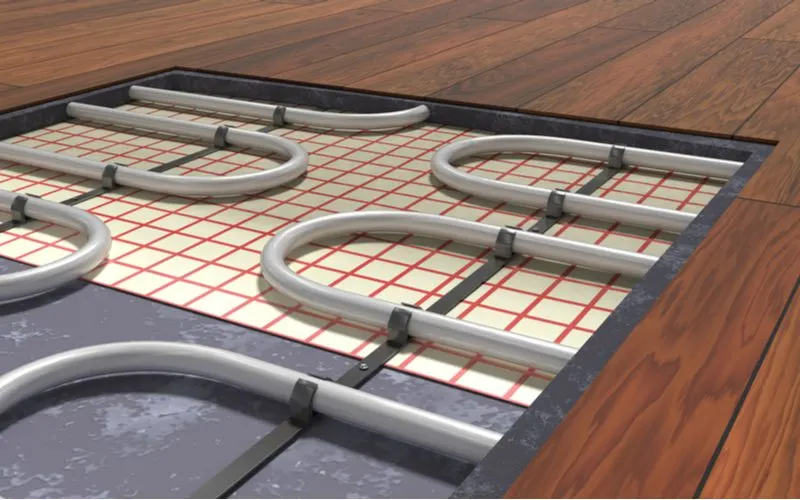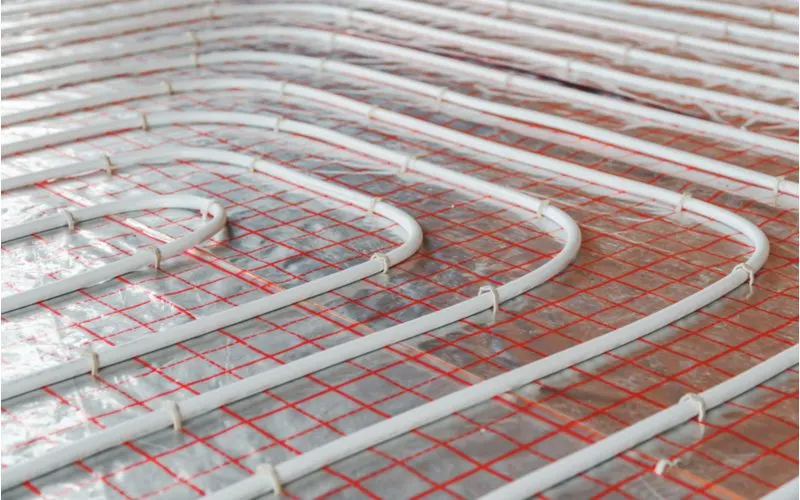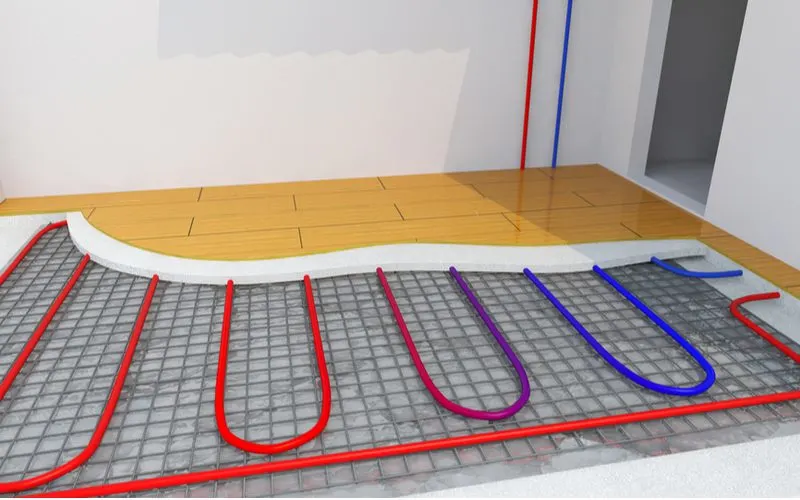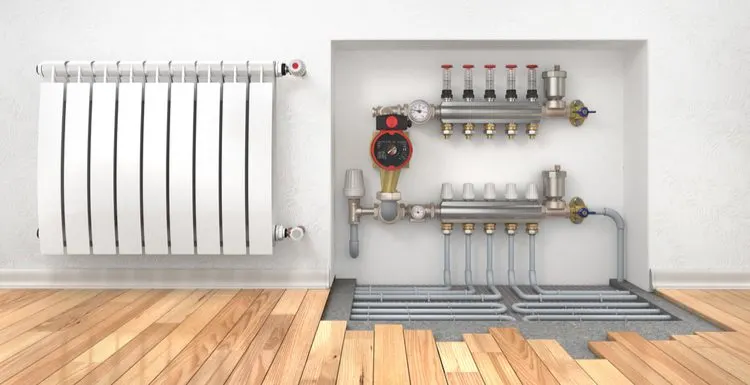Traditional heating systems not only require a lot of maintenance, but a small leak could make your utility bill skyrocket.
Learn about hydronic floor heating, an efficient and effective way to warm your house.
Using Water to Heat Your Home
Hydronic floor heating uses water to heat your home. A series of tubes runs beneath your floor, and water flows from a boiler to heat your home.
You can install this system under various types of flooring, including:
- Wood
- Laminate
- Vinyl
- Linoleum
- Tile
- Stone
Everything to Know About Hydronic Floor Heating

Vchal/Shutterstock
The basic concept behind hydronic floor heating is simple. Using hot water to heat the floor keeps the entire house warmer than blowing hot air into the room.
When you dive into the specifics of hydronic floor heating, there’s a lot to learn.
Open-Loop vs. Closed-Loop Hydronic Heating
You can install a hydronic floor heating system in two different ways: open-loop or closed-loop.
An open-loop system pulls the water from the source, heats it, and pumps it through the tubing once. After it circulates, the system disposes of it.
The closed-loop process reuses the same water. It’s reheated and shuttled through the PEX tubes continuously.
This is not only a more environmentally-friendly option but also prevents bacteria and contaminants from getting into the water cycle.
Regardless of the type of loop you choose, you will install the pipes all across the floor, about three inches apart.
In dry installations, you install the tubes and then put flooring on top of them. You can complete the entire process in just a few days.
Wet installations take longer because you’re covering the tubing with concrete. It takes about three weeks for the concrete to cure before you can install tile, vinyl, laminate, or other types of flooring over it.
Hydronic Heat Sources
There are several different heat sources for hydronic floor heating systems, including:
- Hot water heaters
- Energy-efficient boilers
- Geothermal heaters
- Solar hot water heaters
- Tankless systems
The cost of running your hydronic heat depends on which of those options you choose. Heaters and boilers that use natural gas or propane are more expensive, while electricity won’t increase your utility bill much.
Energy-efficient and solar appliances are the cheapest to run but will cost more on the front end. Over time, your costs will even out.
Plus, you get the satisfaction of knowing that your heating system isn’t harming the environment like others will.
Most hydronic heating uses water as the liquid medium. If you live in a climate with freezing temperatures, you can add antifreeze to the liquid. This prevents it from freezing in the system when you’re not using it.
Hydronic Floor Heating Maintenance
Maintenance for hydronic floor heating is very minor. All of the parts run silently, so if you hear a noise, you should call a professional to check it out.
You’ll have to maintain the boiler or water heater to ensure it’s working properly. An annual checkup from your HVAC professional is enough to keep it running.
The HVAC repair person should check the water pump at the same time as the boiler. Clean it annually so the pressure valves won’t get backed up or worn down.
Beyond this, it doesn’t require maintenance like changing filters or cleaning ductwork. Hydronic floor heating uses cross-linked polyethylene (PEX) tubes.
This is a flexible plastic that is replacing copper pipes in new builds. Because this tubing is easy to work with, it’s possible to install PEX yourself, if necessary.
PEX lasts up to 50 years, so you most likely won’t have to replace it after installation. It’s made to withstand water and other elements without cracking or corroding.
Things to Consider
Now that you have a solid foundation of knowledge about hydronic floor heating, consider these points before installing it in your home.
- While the cost of installing a hydronic floor heating system is expensive when you factor in supplies and labor, you’ll make up the difference with lower utility bills over time.
- Hydronic floor heating differs from the floor heating systems often installed in master bathrooms for additional comfort. You use hydronic systems instead of conventional heating systems.
- Any heating system works better if your house is well-insulated. Insulation can deteriorate over time, so you should inspect it every year.
- Speaking of insulation, carpet and rugs insulate your floor the wrong way—by trapping heat before it gets into your room. Hydronic heating systems work best with tile, wood, vinyl, laminate, and other types of flooring that don’t trap heat.
- Some hydronic systems can also circulate cold water to cool the house, but you typically need a separate cooling system for your house.
Frequently Asked Questions

Vladeep/Shutterstock
Learning the basics about hydronic floor heating shows you that it’s a great option to keep your home warm in cold weather. If you have any lingering questions, you can find the answers here.
Is Hydronic Floor Heating Expensive?
Hydronic floor heating costs about $10 per square foot for dry installations. Because wet installations call for concrete to set the pipes, it averages $14 per square foot. These prices are for the heating system only. You’ll buy your flooring separately to install after the hydronic system is working. The overall price is fairly equal to installing a traditional heating system. However, over time you’ll save money because maintenance and repairs on hydronic systems are much lower than what you’d end up paying for systems using ductwork. It’s also more cost-effective to run hydronic heating systems. They heat the house so efficiently that you can keep the temperature lower, which decreases your utility bill each month. On average, hydronic floor heating is 30% more efficient than traditional heating systems. With zoning, you can control the temperature according to the area. Instead of setting a temperature for the whole house on a traditional thermostat, you can set different temperatures for each room with hydronic heating. You can turn it completely off in unoccupied rooms, saving money on your utility bills.
How Does Hydronic Floor Heating Work?
Hydronic floor heating is a system of flexible tubing installed beneath the floor. Hot water runs through the tubes to heat your house from the ground up.
A pump sends hot water from a boiler through the PEX tubes running through your house. You can control the temperature of the water heater to best suit your family’s needs. This system uses a thermostat like other heating options, so it’s easy to turn off and on, as well as change the temperature.
Can You Put Furniture on Hydronic Floor Heating?
Yes, you can decorate your house with any furniture as long as it doesn’t press flat against the floor. Couches with legs that lift it up from the floor two or three inches allow the air to circulate.
Don’t put a mattress or solid piece of furniture directly on the floor. You also shouldn’t use rugs or carpets if you have hydronic floor heating. These items all trap heat beneath them, so the system won’t warm your entire house.
In addition to decreasing the system’s efficiency, these solid objects can also cause damage to your floor when they get overheated.
Should Hydronic Floor Heating Always Be On?
Because hydronic floor heating is so efficient, you can leave it on all of the time and just change the temperature. It takes up to three hours to heat up if you’ve left it off for a period, so you can lower the temperature to eliminate that warm-up time.
Instead of turning the heat off completely when you leave the house, just lower the temperature, so it’s not working as hard. When you get home and turn the temperature back up, you’ll feel the warmth much sooner.
If you want to go high-tech, get a programmable thermostat installed. They have companion apps so you can change the temperature half an hour before you get home and enter a warm house.
Is Hydronic Floor Heating Worth It?
Yes. It’s efficient and affordable. It also keeps your house warmer than traditional heating systems that blast hot air.
Many people mistakenly think that heat rises, but it’s hot air that rises. When a standard heating system blows hot air into your home, you’ll feel warm for a moment. Then that hot air rises to the ceiling, so you feel cooler in its absence.
Hydronic floor heating doesn’t use hot air; it just uses heat. That means the areas around the floor, furniture, and people in your home get warm first. After the system warms up everything solid, the heat transfers to the air and warms it.
Traditional heating systems rely on ductwork that leaks, wasting heat, energy, and money. Hydronic heating systems use PEX tubes, which last up to 50 years before replacement. If you maintain your water heater, you won’t have to sink money into your heating system for upkeep.
So, What Is Hydronic Floor Heating?

Costazzurra/Shutterstock
Hydronic floor heating is the most efficient way to heat your house. Hot water flows through tubes installed beneath your floors to keep your family warm.
This system works with any type of flooring, so take advantage of it and lower your utility bills.

